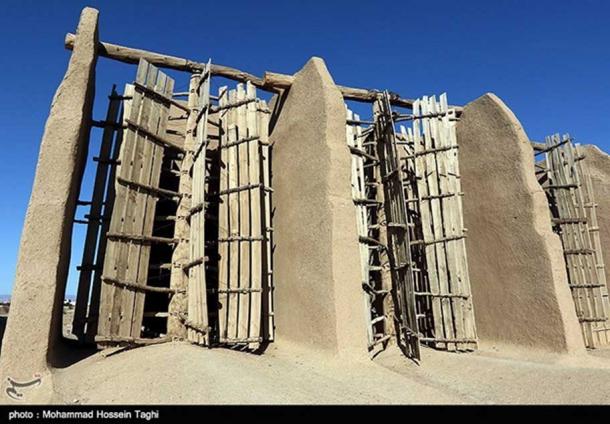
The Future of the Nashtifan Windmills is Blowing in the Wind
Wind power has been used for centuries by humans to move machines that act as a labor saving devices, taking the effort out an otherwise arduous task for man. One set of such machinery not only has been in existence for such a long time, it has actually been functional for the duration. But it’s working life could soon come to an end.
Nashtifan is an ancient site located in Khaf County, which is part of the northeastern Iranian province of Rzavi Khorasan. In olden days, the town was known as ‘Nish Toofan’, which may be translated to mean ‘storm’s sting’, and is an indication of the kind of environment it was in. Due to the strong winds that blow across the area, windmills were built near the town to harness this source of energy. Amazingly, there are still a number of windmills that were built during ancient times, and are still functioning today. Unfortunately, however, the windmills may soon stop turning, as they have to be maintained by a keeper of the windmills, a job that the young are not interested in.
- The Ingenious Invention of the Tower of the Winds
- Ancient Runways and Flying Fish: Did the Nazca Culture Take Flight?
- Developer Plans to Use Ancient Technology to Harness Hydropower

Nashtifan windmills are based on the earliest type of windmill. (CC BY 4.0)
Earliest Windmills
The earliest windmills were built in order to transform grain-grinding and water-pumping from manual tasks to automated ones. The earliest known windmill design was developed in ancient Persia between AD 500 and 900. This design utilised a vertical axis system to harness the power of the wind to pump water. Unfortunately, no drawings of this system have survived, hence the exact method of water transport using such windmills is unknown.

The Asbad structures at Nashtifan, Iran (CC BY 4.0)
The earliest documented design of a windmill is also from Persia. This design consists of a central vertical shaft, onto which are attached horizontal struts with sails made of reed or wood bundles. This type of windmill is known as a ‘panemone windmill’, or an ‘asbad’ in its native country, Iran. It has been speculated that the first asbads were built in Sistan, which is located in the eastern part of Iran. From there, the windmills spread to other parts of the world. This technology was brought to China, for example, during the time of the Mongols, whilst Iran’s connection to the Islamic world allowed this technology to travel to other areas under Islamic rule at that time, including Egypt and Spain.
- Ten amazing inventions from ancient times
- Sandstorm in Iran Reveals Remnants of What is Possibly an Ancient City
- Golden Years: Metal Coating Techniques Used 2000 Years Ago Outshine Modern Methods

Windmill complex of Nashtifan (Ahmad Hassanzadeh/CC BY-SA 4.0)
The Workings of the Nashtifan Thirty
The windmills of Nashtifan are of the asbad type, and have been used for milling grain into flour. It has been reckoned that these windmills have been functioning for about 1000 years. According to another source, the windmills are said to have been built during the Safavid Dynasty, and hence about 500 years at most. At Nashtifan, there are about 30 of these windmills in operation. These structures are made of material readily available in the surrounding area – clay, straw, and wood, and each of them contains eight chambers. Each chamber in turn houses six blades attached to a central vertical shaft. As wind enters the chambers, the blades rotate, which result in the turning of the grindstones that are attached to them. As the area is often buffeted by strong winds with speeds of up to 120 km per hour, it is the ideal condition for the windmills to function. It has been estimated, however, that if these ancient windmills were connected to a generator, they would not even produce enough energy to power up a lightbulb.

An ancient and inefficient ‘green’ technology (CC BY 4.0)
The Future Blows in the Wind
In 2002, the windmills of Nashtifan were recognised as a national heritage site by Iran. In addition, the ancient windmills of Iran are currently on the Tentative List of UNESCO’s World Heritage List. Nevertheless, the recognition conferred upon the site is no guarantee for its future. The progress made by technology over the last centuries means that there are now easier ways for people to grind grain, hence making the windmills much less useful than before. Currently, a man by the name of Mohammad Etebari is in charge of maintaining and keeping the windmills of Nashtifan turning. Unfortunately, it is uncertain if someone else will take over his place when he is gone. If no one does so, then this ancient tradition would die along with Etebari.
Top image: The Nashtifan Windmills. Image: CC BY-SA 4.0)
By Wu Mingren
References
Howard, B. C., 2017. Iran's Centuries-Old Windmills May Soon Stop Turning. [Online]
Available at: https://news.nationalgeographic.com/2017/01/nashtifan-iran-windmills/
Kalout Tour Agency, 2017. The Ancient Windmills of Nashtifan. [Online]
Available at: https://kalouttour.com/ancient-windmills-nashtifan-windmills-building-serves-wind/
Kaushik, 2014. The Ancient Windmills of Nashtifan. [Online]
Available at: http://www.amusingplanet.com/2014/07/the-ancient-windmills-of-nashtifan.html
naturalhomes.or, 2017. The windmills of Iran catching the storm’s sting. [Online]
Available at: http://naturalhomes.org/nashtifaan-windmills.htm
Nitz, B., 2017. World’s oldest windmills may stop in Nashtifan, Iran. [Online]
Available at: https://www.greenprophet.com/2017/04/worlds-oldest-windmills-may-stop-in-nashtifan-iran/
TelosNet, 2017. Wind Power's Beginnings (1000 B.C. - 1300 A.D.). [Online]
Available at: http://www.telosnet.com/wind/early.html
UNESCO, 2017. Asbads (windmill) of Iran. [Online]
Available at: http://whc.unesco.org/en/tentativelists/6192/















